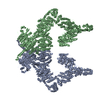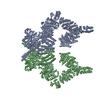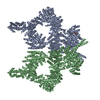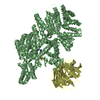+ Open data
Open data
- Basic information
Basic information
| Entry | Database: EMDB / ID: EMD-3669 | |||||||||
|---|---|---|---|---|---|---|---|---|---|---|
| Title | Closed dimer (C1) of human ATM (Ataxia telangiectasia mutated) | |||||||||
 Map data Map data | Closed dimer (C1) of human ATM (Ataxia telangiectasia mutated) | |||||||||
 Sample Sample |
| |||||||||
 Keywords Keywords | PIKK / kinase / DNA-repair / HEAT-repeats / SIGNALING PROTEIN | |||||||||
| Function / homology |  Function and homology information Function and homology informationestablishment of RNA localization to telomere / positive regulation of telomerase catalytic core complex assembly / cellular response to nitrosative stress / negative regulation of telomere capping / establishment of protein-containing complex localization to telomere / Sensing of DNA Double Strand Breaks / peptidyl-serine autophosphorylation / positive regulation of telomere maintenance via telomere lengthening / meiotic telomere clustering / pre-B cell allelic exclusion ...establishment of RNA localization to telomere / positive regulation of telomerase catalytic core complex assembly / cellular response to nitrosative stress / negative regulation of telomere capping / establishment of protein-containing complex localization to telomere / Sensing of DNA Double Strand Breaks / peptidyl-serine autophosphorylation / positive regulation of telomere maintenance via telomere lengthening / meiotic telomere clustering / pre-B cell allelic exclusion / DNA-dependent protein kinase activity / male meiotic nuclear division / extrinsic component of synaptic vesicle membrane / histone H2AXS139 kinase activity / histone mRNA catabolic process / regulation of telomere maintenance via telomerase / female meiotic nuclear division / lipoprotein catabolic process / DNA double-strand break processing / regulation of autophagosome assembly / cellular response to X-ray / V(D)J recombination / pexophagy / oocyte development / Impaired BRCA2 binding to PALB2 / DNA repair complex / reciprocal meiotic recombination / positive regulation of DNA damage response, signal transduction by p53 class mediator / Homologous DNA Pairing and Strand Exchange / Defective homologous recombination repair (HRR) due to BRCA1 loss of function / Defective HDR through Homologous Recombination Repair (HRR) due to PALB2 loss of BRCA1 binding function / Defective HDR through Homologous Recombination Repair (HRR) due to PALB2 loss of BRCA2/RAD51/RAD51C binding function / Resolution of D-loop Structures through Synthesis-Dependent Strand Annealing (SDSA) / 1-phosphatidylinositol-3-kinase activity / Resolution of D-loop Structures through Holliday Junction Intermediates / HDR through Single Strand Annealing (SSA) / response to ionizing radiation / negative regulation of B cell proliferation / cellular response to stress / TP53 Regulates Transcription of Caspase Activators and Caspases / mitotic spindle assembly checkpoint signaling / positive regulation of double-strand break repair / Impaired BRCA2 binding to RAD51 / mitotic G2 DNA damage checkpoint signaling / TP53 Regulates Transcription of Genes Involved in Cytochrome C Release / peroxisomal matrix / Presynaptic phase of homologous DNA pairing and strand exchange / replicative senescence / signal transduction in response to DNA damage / Regulation of HSF1-mediated heat shock response / somitogenesis / regulation of cellular response to heat / ovarian follicle development / cellular response to retinoic acid / negative regulation of TORC1 signaling / positive regulation of telomere maintenance via telomerase / positive regulation of cell adhesion / telomere maintenance / Pexophagy / DNA damage checkpoint signaling / thymus development / regulation of signal transduction by p53 class mediator / determination of adult lifespan / post-embryonic development / cellular response to reactive oxygen species / TP53 Regulates Transcription of DNA Repair Genes / DNA damage response, signal transduction by p53 class mediator / Nonhomologous End-Joining (NHEJ) / Stabilization of p53 / Autodegradation of the E3 ubiquitin ligase COP1 / cellular response to gamma radiation / double-strand break repair via homologous recombination / G2/M DNA damage checkpoint / brain development / Regulation of TP53 Activity through Methylation / HDR through Homologous Recombination (HRR) / double-strand break repair via nonhomologous end joining / DNA Damage/Telomere Stress Induced Senescence / Meiotic recombination / multicellular organism growth / spindle / intrinsic apoptotic signaling pathway in response to DNA damage / cellular senescence / Regulation of TP53 Degradation / double-strand break repair / positive regulation of neuron apoptotic process / Recruitment and ATM-mediated phosphorylation of repair and signaling proteins at DNA double strand breaks / site of double-strand break / heart development / chromosome / protein autophosphorylation / Processing of DNA double-strand break ends / neuron apoptotic process / regulation of apoptotic process / Regulation of TP53 Activity through Phosphorylation / protein phosphorylation / non-specific serine/threonine protein kinase / regulation of cell cycle / regulation of autophagy / positive regulation of cell migration Similarity search - Function | |||||||||
| Biological species |  Homo sapiens (human) Homo sapiens (human) | |||||||||
| Method | single particle reconstruction / cryo EM / Resolution: 5.7 Å | |||||||||
 Authors Authors | Baretic D / Pollard HK | |||||||||
| Funding support |  United Kingdom, 2 items United Kingdom, 2 items
| |||||||||
 Citation Citation |  Journal: Sci Adv / Year: 2017 Journal: Sci Adv / Year: 2017Title: Structures of closed and open conformations of dimeric human ATM. Authors: Domagoj Baretić / Hannah K Pollard / David I Fisher / Christopher M Johnson / Balaji Santhanam / Caroline M Truman / Tomas Kouba / Alan R Fersht / Christopher Phillips / Roger L Williams /  Abstract: ATM (ataxia-telangiectasia mutated) is a phosphatidylinositol 3-kinase-related protein kinase (PIKK) best known for its role in DNA damage response. ATM also functions in oxidative stress response, ...ATM (ataxia-telangiectasia mutated) is a phosphatidylinositol 3-kinase-related protein kinase (PIKK) best known for its role in DNA damage response. ATM also functions in oxidative stress response, insulin signaling, and neurogenesis. Our electron cryomicroscopy (cryo-EM) suggests that human ATM is in a dynamic equilibrium between closed and open dimers. In the closed state, the PIKK regulatory domain blocks the peptide substrate-binding site, suggesting that this conformation may represent an inactive or basally active enzyme. The active site is held in this closed conformation by interaction with a long helical hairpin in the TRD3 (tetratricopeptide repeats domain 3) domain of the symmetry-related molecule. The open dimer has two protomers with only a limited contact interface, and it lacks the intermolecular interactions that block the peptide-binding site in the closed dimer. This suggests that the open conformation may be more active. The ATM structure shows the detailed topology of the regulator-interacting N-terminal helical solenoid. The ATM conformational dynamics shown by the structures represent an important step in understanding the enzyme regulation. | |||||||||
| History |
|
- Structure visualization
Structure visualization
| Movie |
 Movie viewer Movie viewer |
|---|---|
| Structure viewer | EM map:  SurfView SurfView Molmil Molmil Jmol/JSmol Jmol/JSmol |
| Supplemental images |
- Downloads & links
Downloads & links
-EMDB archive
| Map data |  emd_3669.map.gz emd_3669.map.gz | 94.1 MB |  EMDB map data format EMDB map data format | |
|---|---|---|---|---|
| Header (meta data) |  emd-3669-v30.xml emd-3669-v30.xml emd-3669.xml emd-3669.xml | 18.1 KB 18.1 KB | Display Display |  EMDB header EMDB header |
| FSC (resolution estimation) |  emd_3669_fsc.xml emd_3669_fsc.xml | 10.6 KB | Display |  FSC data file FSC data file |
| Images |  emd_3669.png emd_3669.png | 239.2 KB | ||
| Filedesc metadata |  emd-3669.cif.gz emd-3669.cif.gz | 8.3 KB | ||
| Archive directory |  http://ftp.pdbj.org/pub/emdb/structures/EMD-3669 http://ftp.pdbj.org/pub/emdb/structures/EMD-3669 ftp://ftp.pdbj.org/pub/emdb/structures/EMD-3669 ftp://ftp.pdbj.org/pub/emdb/structures/EMD-3669 | HTTPS FTP |
-Validation report
| Summary document |  emd_3669_validation.pdf.gz emd_3669_validation.pdf.gz | 283 KB | Display |  EMDB validaton report EMDB validaton report |
|---|---|---|---|---|
| Full document |  emd_3669_full_validation.pdf.gz emd_3669_full_validation.pdf.gz | 282.1 KB | Display | |
| Data in XML |  emd_3669_validation.xml.gz emd_3669_validation.xml.gz | 11.5 KB | Display | |
| Arichive directory |  https://ftp.pdbj.org/pub/emdb/validation_reports/EMD-3669 https://ftp.pdbj.org/pub/emdb/validation_reports/EMD-3669 ftp://ftp.pdbj.org/pub/emdb/validation_reports/EMD-3669 ftp://ftp.pdbj.org/pub/emdb/validation_reports/EMD-3669 | HTTPS FTP |
-Related structure data
| Related structure data |  5np0MC  3668C  3670C  3671C  3672C  3673C  5np1C M: atomic model generated by this map C: citing same article ( |
|---|---|
| Similar structure data |
- Links
Links
| EMDB pages |  EMDB (EBI/PDBe) / EMDB (EBI/PDBe) /  EMDataResource EMDataResource |
|---|---|
| Related items in Molecule of the Month |
- Map
Map
| File |  Download / File: emd_3669.map.gz / Format: CCP4 / Size: 103 MB / Type: IMAGE STORED AS FLOATING POINT NUMBER (4 BYTES) Download / File: emd_3669.map.gz / Format: CCP4 / Size: 103 MB / Type: IMAGE STORED AS FLOATING POINT NUMBER (4 BYTES) | ||||||||||||||||||||||||||||||||||||||||||||||||||||||||||||
|---|---|---|---|---|---|---|---|---|---|---|---|---|---|---|---|---|---|---|---|---|---|---|---|---|---|---|---|---|---|---|---|---|---|---|---|---|---|---|---|---|---|---|---|---|---|---|---|---|---|---|---|---|---|---|---|---|---|---|---|---|---|
| Annotation | Closed dimer (C1) of human ATM (Ataxia telangiectasia mutated) | ||||||||||||||||||||||||||||||||||||||||||||||||||||||||||||
| Projections & slices | Image control
Images are generated by Spider. | ||||||||||||||||||||||||||||||||||||||||||||||||||||||||||||
| Voxel size | X=Y=Z: 1.43 Å | ||||||||||||||||||||||||||||||||||||||||||||||||||||||||||||
| Density |
| ||||||||||||||||||||||||||||||||||||||||||||||||||||||||||||
| Symmetry | Space group: 1 | ||||||||||||||||||||||||||||||||||||||||||||||||||||||||||||
| Details | EMDB XML:
CCP4 map header:
| ||||||||||||||||||||||||||||||||||||||||||||||||||||||||||||
-Supplemental data
- Sample components
Sample components
-Entire : Dimeric human ATM (Ataxia telangiectasia mutated) kinase
| Entire | Name: Dimeric human ATM (Ataxia telangiectasia mutated) kinase |
|---|---|
| Components |
|
-Supramolecule #1: Dimeric human ATM (Ataxia telangiectasia mutated) kinase
| Supramolecule | Name: Dimeric human ATM (Ataxia telangiectasia mutated) kinase type: organelle_or_cellular_component / ID: 1 / Parent: 0 / Macromolecule list: all / Details: homodimer |
|---|---|
| Source (natural) | Organism:  Homo sapiens (human) Homo sapiens (human) |
| Molecular weight | Theoretical: 705 KDa |
-Macromolecule #1: Serine-protein kinase ATM
| Macromolecule | Name: Serine-protein kinase ATM / type: protein_or_peptide / ID: 1 / Number of copies: 2 / Enantiomer: LEVO / EC number: non-specific serine/threonine protein kinase |
|---|---|
| Source (natural) | Organism:  Homo sapiens (human) Homo sapiens (human) |
| Molecular weight | Theoretical: 352.393969 KDa |
| Recombinant expression | Organism:  Homo sapiens (human) Homo sapiens (human) |
| Sequence | String: MDYKDDDDKH MSLVLNDLLI CCRQLEHDRA TERKKEVEKF KRLIRDPETI KHLDRHSDSK QGKYLNWDAV FRFLQKYIQK ETECLRIAK PNVSASTQAS RQKKMQEISS LVKYFIKCAN RRAPRLKCQE LLNYIMDTVK DSSNGAIYGA DCSNILLKDI L SVRKYWCE ...String: MDYKDDDDKH MSLVLNDLLI CCRQLEHDRA TERKKEVEKF KRLIRDPETI KHLDRHSDSK QGKYLNWDAV FRFLQKYIQK ETECLRIAK PNVSASTQAS RQKKMQEISS LVKYFIKCAN RRAPRLKCQE LLNYIMDTVK DSSNGAIYGA DCSNILLKDI L SVRKYWCE ISQQQWLELF SVYFRLYLKP SQDVHRVLVA RIIHAVTKGC CSQTDGLNSK FLDFFSKAIQ CARQEKSSSG LN HILAALT IFLKTLAVNF RIRVCELGDE ILPTLLYIWT QHRLNDSLKE VIIELFQLQI YIHHPKGAKT QEKGAYESTK WRS ILYNLY DLLVNEISHI GSRGKYSSGF RNIAVKENLI ELMADICHQV FNEDTRSLEI SQSYTTTQRE SSDYSVPCKR KKIE LGWEV IKDHLQKSQN DFDLVPWLQI ATQLISKYPA SLPNCELSPL LMILSQLLPQ QRHGERTPYV LRCLTEVALC QDKRS NLES SQKSDLLKLW NKIWCITFRG ISSEQIQAEN FGLLGAIIQG SLVEVDREFW KLFTGSACRP SCPAVCCLTL ALTTSI VPG TVKMGIEQNM CEVNRSFSLK ESIMKWLLFY QLEGDLENST EVPPILHSNF PHLVLEKILV SLTMKNCKAA MNFFQSV PE CEHHQKDKEE LSFSEVEELF LQTTFDKMDF LTIVRECGIE KHQSSIGFSV HQNLKESLDR CLLGLSEQLL NNYSSEIT N SETLVRCSRL LVGVLGCYCY MGVIAEEEAY KSELFQKAKS LMQCAGESIT LFKNKTNEEF RIGSLRNMMQ LCTRCLSNC TKKSPNKIAS GFFLRLLTSK LMNDIADICK SLASFIKKPF DRGEVESMED DTNGNLMEVE DQSSMNLFND YPDSSVSDAN EPGESQSTI GAINPLAEEY LSKQDLLFLD MLKFLCLCVT TAQTNTVSFR AADIRRKLLM LIDSSTLEPT KSLHLHMYLM L LKELPGEE YPLPMEDVLE LLKPLSNVCS LYRRDQDVCK TILNHVLHVV KNLGQSNMDS ENTRDAQGQF LTVIGAFWHL TK ERKYIFS VRMALVNCLK TLLEADPYSK WAILNVMGKD FPVNEVFTQF LADNHHQVRM LAAESINRLF QDTKGDSSRL LKA LPLKLQ QTAFENAYLK AQEGMREMSH SAENPETLDE IYNRKSVLLT LIAVVLSCSP ICEKQALFAL CKSVKENGLE PHLV KKVLE KVSETFGYRR LEDFMASHLD YLVLEWLNLQ DTEYNLSSFP FILLNYTNIE DFYRSCYKVL IPHLVIRSHF DEVKS IANQ IQEDWKSLLT DCFPKILVNI LPYFAYEGTR DSGMAQQRET ATKVYDMLKS ENLLGKQIDH LFISNLPEIV VELLMT LHE PANSSASQST DLCDFSGDLD PAPNPPHFPS HVIKATFAYI SNCHKTKLKS ILEILSKSPD SYQKILLAIC EQAAETN NV YKKHRILKIY HLFVSLLLKD IKSGLGGAWA FVLRDVIYTL IHYINQRPSC IMDVSLRSFS LCCDLLSQVC QTAVTYCK D ALENHLHVIV GTLIPLVYEQ VEVQKQVLDL LKYLVIDNKD NENLYITIKL LDPFPDHVVF KDLRITQQKI KYSRGPFSL LEEINHFLSV SVYDALPLTR LEGLKDLRRQ LELHKDQMVD IMRASQDNPQ DGIMVKLVVN LLQLSKMAIN HTGEKEVLEA VGSCLGEVG PIDFSTIAIQ HSKDASYTKA LKLFEDKELQ WTFIMLTYLN NTLVEDCVKV RSAAVTCLKN ILATKTGHSF W EIYKMTTD PMLAYLQPFR TSRKKFLEVP RFDKENPFEG LDDINLWIPL SENHDIWIKT LTCAFLDSGG TKCEILQLLK PM CEVKTDF CQTVLPYLIH DILLQDTNES WRNLLSTHVQ GFFTSCLRHF SQTSRSTTPA NLDSESEHFF RCCLDKKSQR TML AVVDYM RRQKRPSSGT IFNDAFWLDL NYLEVAKVAQ SCAAHFTALL YAEIYADKKS MDDQEKRSLA FEEGSQSTTI SSLS EKSKE ETGISLQDLL LEIYRSIGEP DSLYGCGGGK MLQPITRLRT YEHEAMWGKA LVTYDLETAI PSSTRQAGII QALQN LGLC HILSVYLKGL DYENKDWCPE LEELHYQAAW RNMQWDHCTS VSKEVEGTSY HESLYNALQS LRDREFSTFY ESLKYA RVK EVEEMCKRSL ESVYSLYPTL SRLQAIGELE SIGELFSRSV THRQLSEVYI KWQKHSQLLK DSDFSFQEPI MALRTVI LE ILMEKEMDNS QRECIKDILT KHLVELSILA RTFKNTQLPE RAIFQIKQYN SVSCGVSEWQ LEEAQVFWAK KEQSLALS I LKQMIKKLDA SCAANNPSLK LTYTECLRVC GNWLAETCLE NPAVIMQTYL EKAVEVAGNY DGESSDELRN GKMKAFLSL ARFSDTQYQR IENYMKSSEF ENKQALLKRA KEEVGLLREH KIQTNRYTVK VQRELELDEL ALRALKEDRK RFLCKAVENY INCLLSGEE HDMWVFRLCS LWLENSGVSE VNGMMKRDGM KIPTYKFLPL MYQLAARMGT KMMGGLGFHE VLNNLISRIS M DHPHHTLF IILALANANR DEFLTKPEVA RRSRITKNVP KQSSQLDEDR TEAANRIICT IRSRRPQMVR SVEALCDAYI IL ANLDATQ WKTQRKGINI PADQPITKLK NLEDVVVPTM EIKVDHTGEY GNLVTIQSFK AEFRLAGGVN LPKIIDCVGS DGK ERRQLV KGRDDLRQDA VMQQVFQMCN TLLQRNTETR KRKLTICTYK VVPLSQRSGV LEWCTGTVPI GEFLVNNEDG AHKR YRPND FSAFQCQKKM MEVQKKSFEE KYEVFMDVCQ NFQPVFRYFC MEKFLDPAIW FEKRLAYTRS VATSSIVGYI LGLGD RHVQ NILINEQSAE LVHIDLGVAF EQGKILPTPE TVPFRLTRDI VDGMGITGVE GVFRRCCEKT MEVMRNSQET LLTIVE VLL YDPLFDWTMN PLKALYLQQR PEDETELHPT LNADDQECKR NLSDIDQSFN KVAERVLMRL QEKLKGVEEG TVLSVGG QV NLLIQQAIDP KNLSRLFPGW KAWV UniProtKB: Serine-protein kinase ATM |
-Experimental details
-Structure determination
| Method | cryo EM |
|---|---|
 Processing Processing | single particle reconstruction |
| Aggregation state | particle |
- Sample preparation
Sample preparation
| Concentration | 0.6 mg/mL | ||||||||||||||||||
|---|---|---|---|---|---|---|---|---|---|---|---|---|---|---|---|---|---|---|---|
| Buffer | pH: 8 Component:
| ||||||||||||||||||
| Grid | Model: Quantifoil, UltrAuFoil, R1.2/1.3 / Material: GOLD / Mesh: 300 | ||||||||||||||||||
| Vitrification | Cryogen name: ETHANE / Chamber humidity: 100 % / Chamber temperature: 277.15 K / Instrument: HOMEMADE PLUNGER / Details: 3 uL of sample/grid blotted for 12 s. | ||||||||||||||||||
| Details | N-terminally FLAG-tagged ATM kinase was purified by affinity chromatography (anti-FLAG), overnight dialysis and gel-filtration. The sample was flash-frozen in liquid nitrogen until used for cryo-EM. |
- Electron microscopy
Electron microscopy
| Microscope | FEI TITAN KRIOS |
|---|---|
| Temperature | Min: 80.15 K |
| Specialist optics | Energy filter - Name: GIF / Energy filter - Lower energy threshold: 0 eV / Energy filter - Upper energy threshold: 20 eV |
| Image recording | Film or detector model: GATAN K2 SUMMIT (4k x 4k) / Detector mode: SUPER-RESOLUTION / Digitization - Frames/image: 1-20 / Number grids imaged: 4 / Number real images: 2720 / Average exposure time: 0.8 sec. / Average electron dose: 2.1 e/Å2 |
| Electron beam | Acceleration voltage: 300 kV / Electron source:  FIELD EMISSION GUN FIELD EMISSION GUN |
| Electron optics | C2 aperture diameter: 70.0 µm / Calibrated magnification: 35714 / Illumination mode: FLOOD BEAM / Imaging mode: BRIGHT FIELD / Cs: 2.7 mm / Nominal defocus max: 4.0 µm / Nominal defocus min: 2.5 µm / Nominal magnification: 97902 |
| Sample stage | Specimen holder model: FEI TITAN KRIOS AUTOGRID HOLDER / Cooling holder cryogen: NITROGEN |
| Experimental equipment |  Model: Titan Krios / Image courtesy: FEI Company |
+ Image processing
Image processing
-Atomic model buiding 1
| Initial model | PDB ID: Chain - Source name: PDB / Chain - Initial model type: experimental model Details: building de novo the structure of ATM N-solenoid and modelling of the ATM FATKIN (using mTOR FATKIN PDB:4JSP) |
|---|---|
| Refinement | Space: REAL |
| Output model |  PDB-5np0: |
 Movie
Movie Controller
Controller





























 Z (Sec.)
Z (Sec.) Y (Row.)
Y (Row.) X (Col.)
X (Col.)























